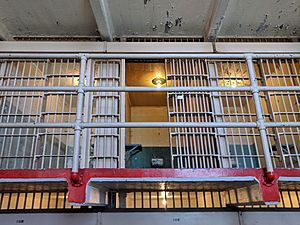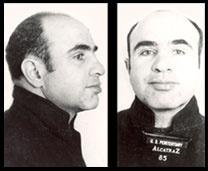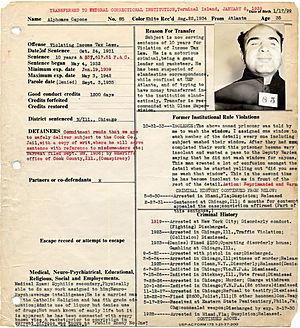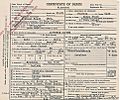Al Capone facts for kids
Quick facts for kids Al Capone |
|
|---|---|

Capone in 1930
|
|
| Born | Alphonse Gabriel Capone January 17, 1899 New York City, U.S. |
| Died | January 25, 1947 (aged 48) Palm Island, Florida, U.S. |
| Alias(es) |
|
| Allegiance | Chicago Outfit |
| Conviction(s) | Tax evasion (26 U.S.C. § 145) (5 counts) |
| Penalty | 11 years imprisonment (1931) |
| Occupation |
|
| Spouse |
Mae Coughlin
(m. 1918) |
| Children | 1 |
Alphonse Gabriel Capone ( January 17, 1899 – January 25, 1947), sometimes known by the nickname "Scarface", was an American gangster and businessman who attained notoriety during the Prohibition era as the co-founder and boss of the Chicago Outfit from 1925 to 1931. His seven-year reign as a crime boss ended when he went to prison at the age of 33.
Contents
Early life
Alphonse Gabriel Capone was born in Brooklyn, a borough of New York City, on January 17, 1899. His parents were Italian immigrants Gabriele Capone (1865–1920) and Teresa Capone (née Raiola; 1867–1952). His father was a barber and his mother was a seamstress, both born in Angri, a small comune outside of Naples in the Province of Salerno. Capone's family had immigrated to the United States in 1893 by ship, first going through Fiume (modern-day Rijeka, Croatia), a port city in what was then Austria-Hungary. The family settled at 95 Navy Street, in the Navy Yard section of Brooklyn. When Al was aged 11, he and his family moved to 38 Garfield Place in Park Slope, Brooklyn.
Capone's parents had eight other children: James Vincenzo Capone, who later changed his name to Richard Hart and became a Prohibition agent in Homer, Nebraska; Raffaele James Capone, also known as Ralph Capone or "Bottles", who took charge of his brother's beverage industry; Salvatore "Frank" Capone; Ermina Capone, who died at the age of one; Ermino "John" Capone; Albert Capone; Matthew Capone and Mafalda Capone. Ralph and Frank worked with Al Capone in his criminal empire. Frank did so until his death on April 1, 1924. Ralph ran Capone's bottling companies (both legal and illegal) early on and was also the front man for the Chicago Outfit until he was imprisoned for tax evasion in 1932.
Al Capone showed promise as a student but had trouble with the rules at his strict parochial Catholic school. His schooling ended at the age of 14 after he was expelled for hitting a female teacher. Capone worked at odd jobs around Brooklyn, including a candy store and a bowling alley. From 1916 to 1918 he played semi-professional baseball. Following this, Capone was influenced by gangster Johnny Torrio, whom he came to regard as a mentor.
Career
Capone joined the Five Points Gang as a teenager and became a bouncer in organized crime premises. In his early twenties, Capone moved to Chicago and became a bodyguard and trusted factotum for Johnny Torrio, head of a criminal syndicate that illegally supplied alcohol—the forerunner of the Outfit—and was politically protected through the Unione Siciliana. A conflict with the North Side Gang was instrumental in Capone's rise and fall. Torrio went into retirement after North Side gunmen almost killed him, handing control to Capone. Capone expanded the bootlegging business through increasingly violent means, but his mutually profitable relationships with Mayor William Hale Thompson and the Chicago Police Department meant he seemed safe from law enforcement.
The Saint Valentine's Day Massacre, in which seven gang rivals were murdered in broad daylight, damaged the public image of Chicago and Capone, leading influential citizens to demand government action and newspapers to dub Capone "Public Enemy No. 1".
Federal authorities became intent on jailing Capone and charged him with twenty-two counts of tax evasion. He was convicted of five counts in 1931. During a highly publicized case, the judge admitted as evidence Capone's admissions of his income and unpaid taxes, made during prior negotiations to pay the government taxes he owed. He was convicted and sentenced to eleven years in federal prison. After conviction, he replaced his defense team with experts in tax law, and his grounds for appeal were strengthened by a Supreme Court ruling, but his appeal ultimately failed.
Imprisonment
Capone was sent to Atlanta U.S. Penitentiary in May 1932, aged 33. Upon his arrival at Atlanta, Capone was competent at his prison job of stitching soles on shoes for eight hours a day, but his letters were barely coherent. He was seen as a weak personality, and so out of his depth dealing with bullying at the hands of fellow inmates that his cellmate, seasoned convict Red Rudensky, feared that Capone would have a breakdown. Rudensky was formerly a small-time criminal associated with the Capone gang and found himself becoming a protector for Capone. The conspicuous protection by Rudensky and other prisoners drew accusations from less friendly inmates and fueled suspicion that Capone was receiving special treatment. No solid evidence ever emerged, but it formed part of the rationale for moving Capone to the recently opened Alcatraz Federal Penitentiary off the coast of San Francisco, in August 1934.
Due to his good behavior, Capone was permitted to play banjo in the Alcatraz prison band, the Rock Islanders, which gave regular Sunday concerts for other inmates. Capone also transcribed the song "Madonna Mia" creating his own arrangement as a tribute to his wife Mae.
At Alcatraz, Capone's decline became increasingly evident, with his mental faculties progressively being eroded; his formal diagnosis was made in February 1938. He spent the last year of his Alcatraz sentence in the hospital section, confused and disoriented. Capone completed his term in Alcatraz on January 6, 1939, and was transferred to the Federal Correctional Institution at Terminal Island in California to serve out his sentence for contempt of court. He was paroled on November 16, 1939, after his wife Mae appealed to the court, based on his reduced mental capabilities.
Illness and death
Due to his failing health, Capone was released from prison on November 16, 1939, and referred to Johns Hopkins Hospital in Baltimore. Because of his unsavory reputation, Johns Hopkins refused to treat him, but Baltimore's Union Memorial Hospital did. Capone was grateful for the compassionate care that he received and donated two Japanese weeping cherry trees to Union Memorial Hospital in 1939. After a few weeks of inpatient and outpatient care, on March 20, 1940, a very sickly Capone left Baltimore and travelled to his mansion in Palm Island, Florida. In 1942, after mass production of penicillin was started in the United States, Capone was one of the first American patients treated by the new drug. Though it was too late for him to reverse the damage to his brain, it did slow down the progression of the disease.
In 1946, his physician and a Baltimore psychiatrist examined him and concluded that Capone had the mentality of a 12-year-old child. He spent the last years of his life at his Palm Island mansion, spending time with his wife and grandchildren. On January 21, 1947, Capone had a stroke. He regained consciousness and started to improve, but contracted bronchopneumonia. He suffered a cardiac arrest on January 22, and on January 25, surrounded by his family in his home, died after his heart failed as a result of apoplexy. His body was transported back to Chicago a week later and a private funeral was held. He was originally buried at Mount Olivet Cemetery in Chicago. In 1950, Capone's remains, along with those of his father, Gabriele, and brother, Frank, were moved to Mount Carmel Cemetery in Hillside, Illinois.
-
Capone's grave in Mount Carmel Cemetery, Hillside, Illinois
Personal life
Capone married Mae Josephine Coughlin at age 19, on December 30, 1918. She was Irish Catholic and earlier that month had given birth to their son Albert Francis "Sonny" Capone (1918–2004). Albert lost most of his hearing in his left ear as a child. Capone was under the age of 21, and his parents had to consent in writing to the marriage. By all accounts, the two had a happy marriage.
Capone apparently reveled in attention, such as the cheers from spectators when he appeared at baseball games. He made donations to various charities and up to a point was viewed by many as a "modern-day Robin Hood".
Al Capone quotes
- “Be careful who you call your friends. I’d rather have four quarters than one hundred pennies.”
- “Don't mistake my kindness for weakness. I am kind to everyone, but when someone is unkind to me, weak is not what you are going to remember about me.”
- I am like any other man. All I do is supply a demand."
- "When I sell liquor, it's bootlegging. When my patrons serve it on a silver tray on Lakeshore Drive, it's hospitality."
Interesting facts about Al Capone
- Al Capone was called Scarface due to an incident where he received scars on his face. A man named Frank Galluccio slashed Capone's face with a knife or razor after Capone made a crude comment to Galluccio's sister.
- Al Capone had several other nicknames besides "Scarface." Close friends called him "Snorky," which was a slang term meaning someone who dressed well. Others referred to him as "Big Fellow."
- Al had street smarts. He left school in middle school.
- After dropping out of school, Al Capone joined several different young gangs such as South Brooklyn Rippers, Forty Thieves Juniors, and James Street Boys.
- Capone worked odd jobs after leaving school and played semi-pro baseball with his brother Ralph.
- It is believed that Capone organized the St. Valentine’s Day Massacre.
- He was among the earliest federal prisoners at Alcatraz.
Images for kids
-
Unemployed men outside a soup kitchen opened by Capone in Chicago during the Depression, February 1931
-
Capone's cell at the now decommissioned Eastern State Penitentiary in Philadelphia, where he spent about nine months starting in May 1929
See also
 In Spanish: Al Capone para niños
In Spanish: Al Capone para niños
- List of Depression-era outlaws
- The Mystery of Al Capone's Vaults
- Al Capone bibliography











